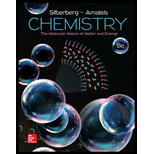
Concept explainers
(a)
Interpretation:
From the given buffer solutions, the solution can react with largest amount of added strong base has to be identified.
Concept Introduction:
Buffer solution:
An aqueous solution consisting mixture of weak base and its conjugate acid or weak acid and its conjugate base. Its
Buffer capacity:
A quantitative measure of the resistance of a buffer solution to pH value change on the addition of hydrogen ion or hydroxide ion is known as buffer capacity.
If u have two or more buffer solutions, then slowly add acid to the each of the solutions and see how much the pH value changes with each addition of acid for each solution. The solution which has the least amount of change in pH value is the best buffer solution and has the highest buffering capacity.
If a buffer has high capacity then it has a great resistance to
(b)
Interpretation:
From the given buffer solutions, the buffer with highest
Concept Introduction:
Buffer solution:
An aqueous solution consisting mixture of weak base and its conjugate acid or weak acid and its conjugate base. Its
Buffer capacity:
A quantitative measure of the resistance of a buffer solution to pH value change on the addition of hydrogen ion or hydroxide ion is known as buffer capacity.
If u have two or more buffer solutions, then slowly add acid to the each of the solutions and see how much the pH value changes with each addition of acid for each solution. The solution which has the least amount of change in pH value is the best buffer solution and has the highest buffering capacity.
If a buffer has high capacity then it has a great resistance to
(c)
Interpretation:
From the given buffer solutions, the solution having
Concept Introduction:
Buffer solution:
An aqueous solution consisting mixture of weak base and its conjugate acid or weak acid and its conjugate base. Its
Buffer capacity:
A quantitative measure of the resistance of a buffer solution to pH value change on the addition of hydrogen ion or hydroxide ion is known as buffer capacity.
If u have two or more buffer solutions, then slowly add acid to the each of the solutions and see how much the pH value changes with each addition of acid for each solution. The solution which has the least amount of change in pH value is the best buffer solution and has the highest buffering capacity.
If a buffer has high capacity then it has a great resistance to
Want to see the full answer?
Check out a sample textbook solution
Chapter 19 Solutions
CONNECT ACCESS CARD FOR CHEMISTRY: MOLECULAR NATURE OF MATTER AND CHANGE
- Please answer the question and provide detailed explanations.arrow_forwardAll of these compounds would be produced (I think). In my book, I don't see any rules about yield in this case, like explaining that one product would be present in less yield for this reason or that reason. Please explain why some of these produce less yield than others.arrow_forward5. Fill in the missing molecules in the following reaction pathway. TMSO Heat + CI then HF O₂N (1.0 equiv) AICI 3 OMearrow_forward
- e. O₂N NO2 1. excess H2, Pd/C 2. excess NaNO2, HCI 3. excess CuCNarrow_forwardHelp with a periodic table task.' Procedure Part 1: Customizing a Periodic Table Use a textbook or other valid source to determine which elements are metals, nonmetals, metalloids (called semimetals in some texts), alkali metals, alkaline earth metals, transition metals, halogens, and noble gases. Download and print a copy of the Periodic Table of Elements. Use colored pencils, colorful highlighters, or computer drawing tools to devise a schematic for designating each of the following on the periodic table: Group numbers Period number Labels for these groups: alkali metals, alkaline earth metals, transition metals, inner transition metals (lanthanides and actinides), other metals, metalloids (semimetals), other nonmetals, halogens, and noble gases Metals, nonmetals, and metalloids Note: Write the group and period numbers and color/highlight each element for categorization. Be sure to include a key for the schematic. Take a photo of the completed periodic table and upload the…arrow_forwardDon't used hand raiting and don't used Ai solutionarrow_forward
- Can you explain these two problems for mearrow_forward个 ^ Blackboard x Organic Chemistry II Lecture (m x Aktiv Learning App x → C app.aktiv.com ← Curved arrows are used to illustrate the flow of electrons. Using the provided starting and product structures, draw the curved electron-pushing arrows for the following reaction or mechanistic step(s). Be sure to account for all bond-breaking and bond-making steps. Problem 28 of 35 :OH H HH KO Select to Edit Arrows CH CH₂OK, CH CH2OH 5+ H :0: Donearrow_forwardCan you explain those two problems for me please.arrow_forward
- Do we need to draw the "ethyne" first for this problem? im confusedarrow_forwardCan you explain how this problem was solved.arrow_forwardQuestion 2 show work. don't Compound give Ai generated solution So (J K-1 mol-1) A 26 B 54 C 39 D 49 At 298 K, AG° is 375 kJ for the reaction 1A + 1B → 4C + 2D Calculate AH° for this reaction in kJ.arrow_forward
 ChemistryChemistryISBN:9781305957404Author:Steven S. Zumdahl, Susan A. Zumdahl, Donald J. DeCostePublisher:Cengage Learning
ChemistryChemistryISBN:9781305957404Author:Steven S. Zumdahl, Susan A. Zumdahl, Donald J. DeCostePublisher:Cengage Learning ChemistryChemistryISBN:9781259911156Author:Raymond Chang Dr., Jason Overby ProfessorPublisher:McGraw-Hill Education
ChemistryChemistryISBN:9781259911156Author:Raymond Chang Dr., Jason Overby ProfessorPublisher:McGraw-Hill Education Principles of Instrumental AnalysisChemistryISBN:9781305577213Author:Douglas A. Skoog, F. James Holler, Stanley R. CrouchPublisher:Cengage Learning
Principles of Instrumental AnalysisChemistryISBN:9781305577213Author:Douglas A. Skoog, F. James Holler, Stanley R. CrouchPublisher:Cengage Learning Organic ChemistryChemistryISBN:9780078021558Author:Janice Gorzynski Smith Dr.Publisher:McGraw-Hill Education
Organic ChemistryChemistryISBN:9780078021558Author:Janice Gorzynski Smith Dr.Publisher:McGraw-Hill Education Chemistry: Principles and ReactionsChemistryISBN:9781305079373Author:William L. Masterton, Cecile N. HurleyPublisher:Cengage Learning
Chemistry: Principles and ReactionsChemistryISBN:9781305079373Author:William L. Masterton, Cecile N. HurleyPublisher:Cengage Learning Elementary Principles of Chemical Processes, Bind...ChemistryISBN:9781118431221Author:Richard M. Felder, Ronald W. Rousseau, Lisa G. BullardPublisher:WILEY
Elementary Principles of Chemical Processes, Bind...ChemistryISBN:9781118431221Author:Richard M. Felder, Ronald W. Rousseau, Lisa G. BullardPublisher:WILEY





